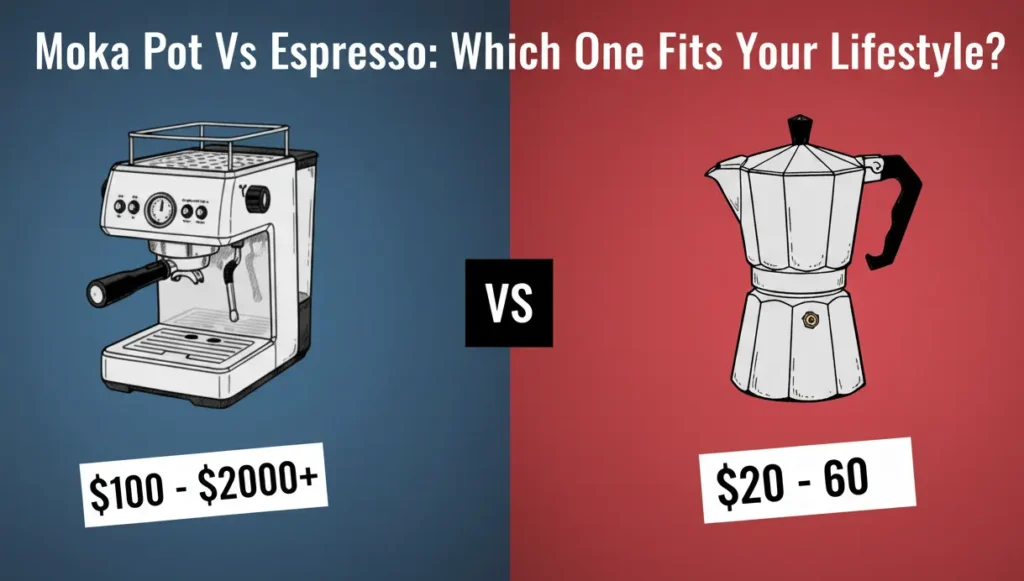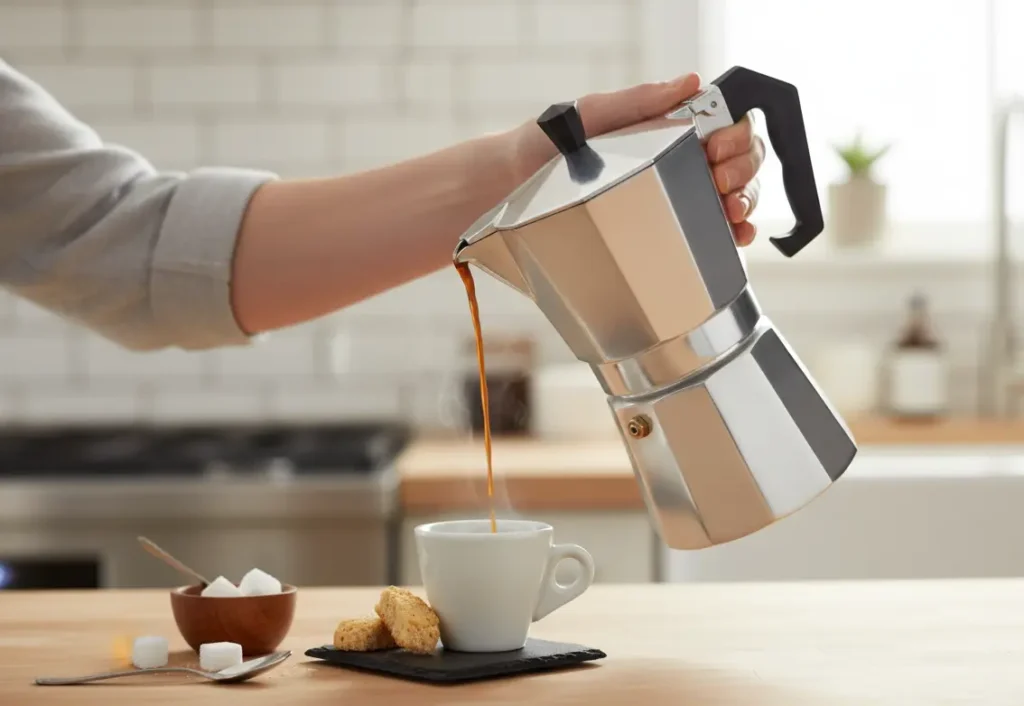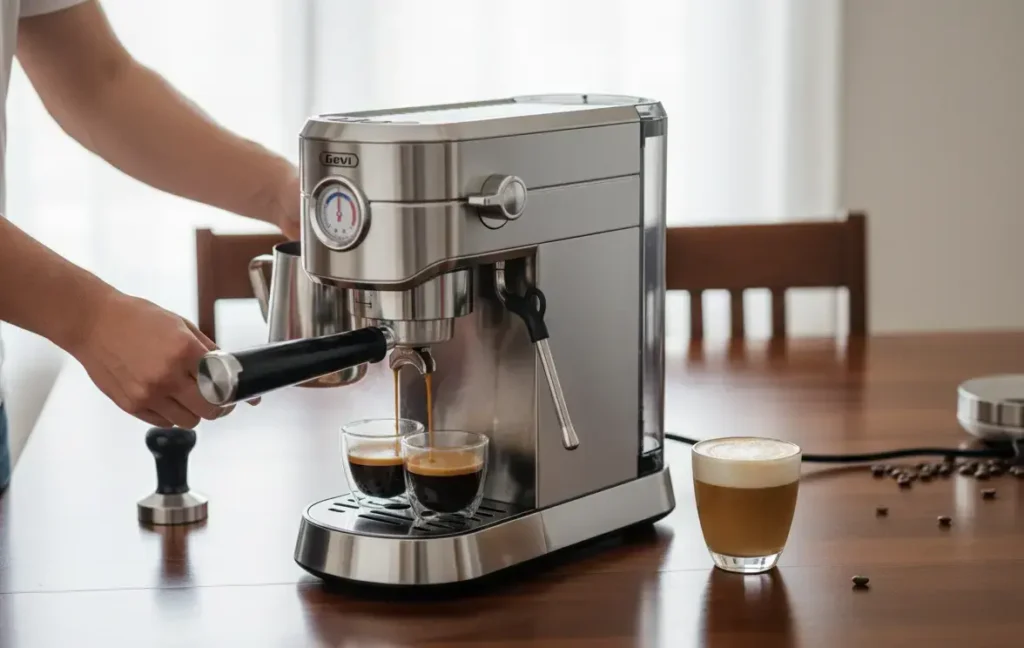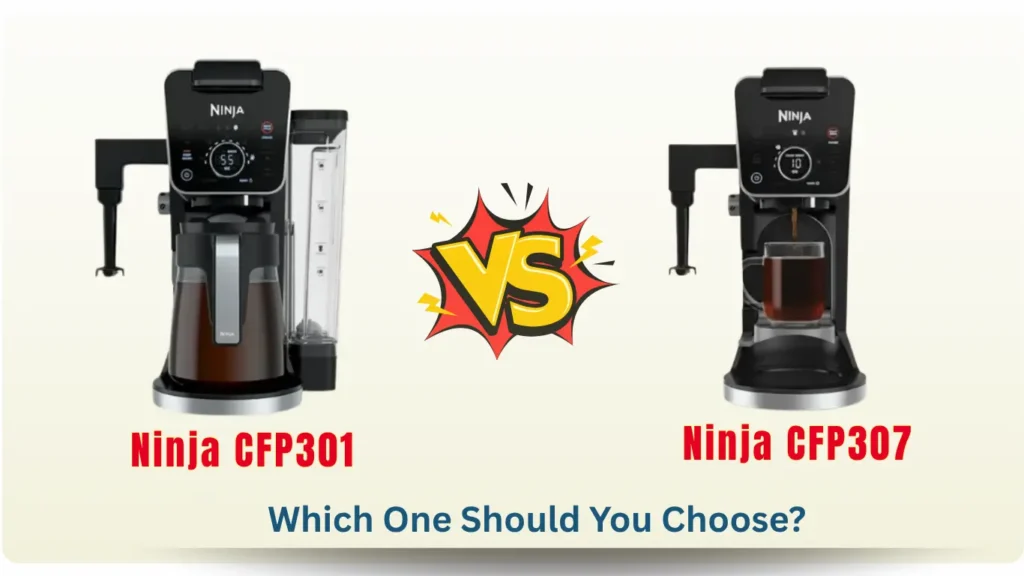Are you confused about whether to buy a coffee maker or an espresso machine? If you love coffee but aren’t sure which device suits your taste and lifestyle, you’re not alone.
Both machines brew coffee, but they do it very differently—and the result you get in your cup can change a lot. Understanding these differences can help you make the best choice for your morning routine and your budget. Keep reading, and you’ll discover how each machine works, what kind of coffee they produce, and which one matches your perfect cup.
By the end, you’ll know exactly what fits your coffee cravings and how to enjoy every sip.
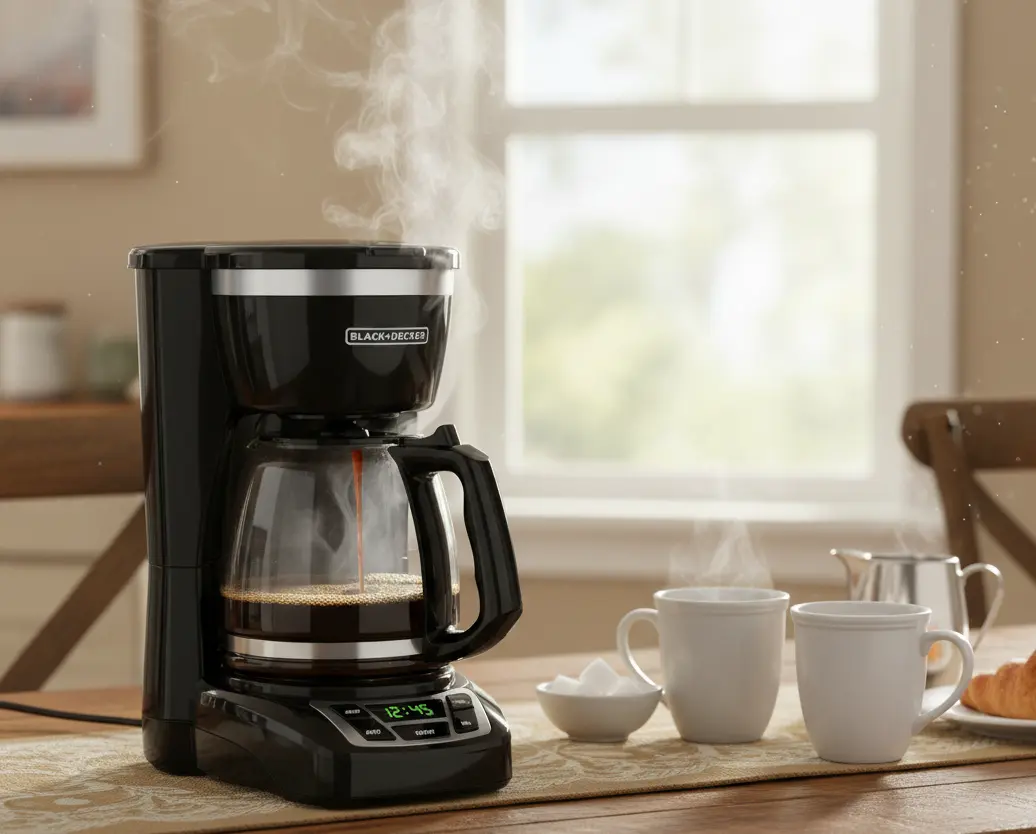
How Does a Coffee Maker Work?
A coffee maker brews coffee by letting hot water drip through medium to coarse coffee grounds. This process uses gravity, not pressure, to extract flavor slowly. The typical grind size is medium coarse, which allows water to flow evenly without clogging.
The flavor profile of coffee from a coffee maker is usually milder and less intense. It has a smoother taste with less bitterness because the brewing time is longer and the temperature is lower.
How Does an Espresso Machine Work?
An espresso machine uses high pressure to push hot water through coffee grounds. This pressure extracts rich flavors and oils quickly. The coffee grind must be very fine, almost like powder, to allow proper extraction.
This process creates a thick layer called crema on top of the espresso. Crema is a sign of a strong and fresh shot. The result is a concentrated coffee with bold taste and aroma.
Types of Coffee Makers and Espresso Machines
Ever walked into a store and felt lost among coffee machines? I get it — there are so many choices, and each one brews differently. Let’s keep it simple so you can find the one that fits your daily rhythm.
Types of Coffee Makers
Drip Coffee Maker – The Everyday Hero: Brews smooth, mild coffee with hot water dripping over coarse grounds. Perfect for big, easy morning cups.
Single-Serve Pod Machine – Quick and Clean: Pop in a pod and press a button. Great for busy mornings and fast coffee with no mess.
French Press – The Hands-On Favorite: Add coffee, pour water, and press. Makes bold, rich coffee that feels warm and homemade.
Pour-Over – The Coffee Purist’s Choice: Pour water slowly over fresh grounds. Brings out delicate flavors and sweet aromas.
Types of Espresso Machines
Manual Espresso Machine – For the True Artist: You control every step for a barista-style espresso. Takes practice but delivers a perfect shot.
Semi-Automatic Machine – The Balanced Choice: Offers control with easy brewing. Ideal if you enjoy hands-on espresso without extra hassle.
Fully Automatic Machine – Effortless Perfection: One touch does it all — grinding, brewing, and milk frothing. Perfect for quick, consistent espresso.
Pod Espresso Machine – Compact and Convenient: Uses pods for a fast espresso with smooth crema. Easy to use and great for small spaces.
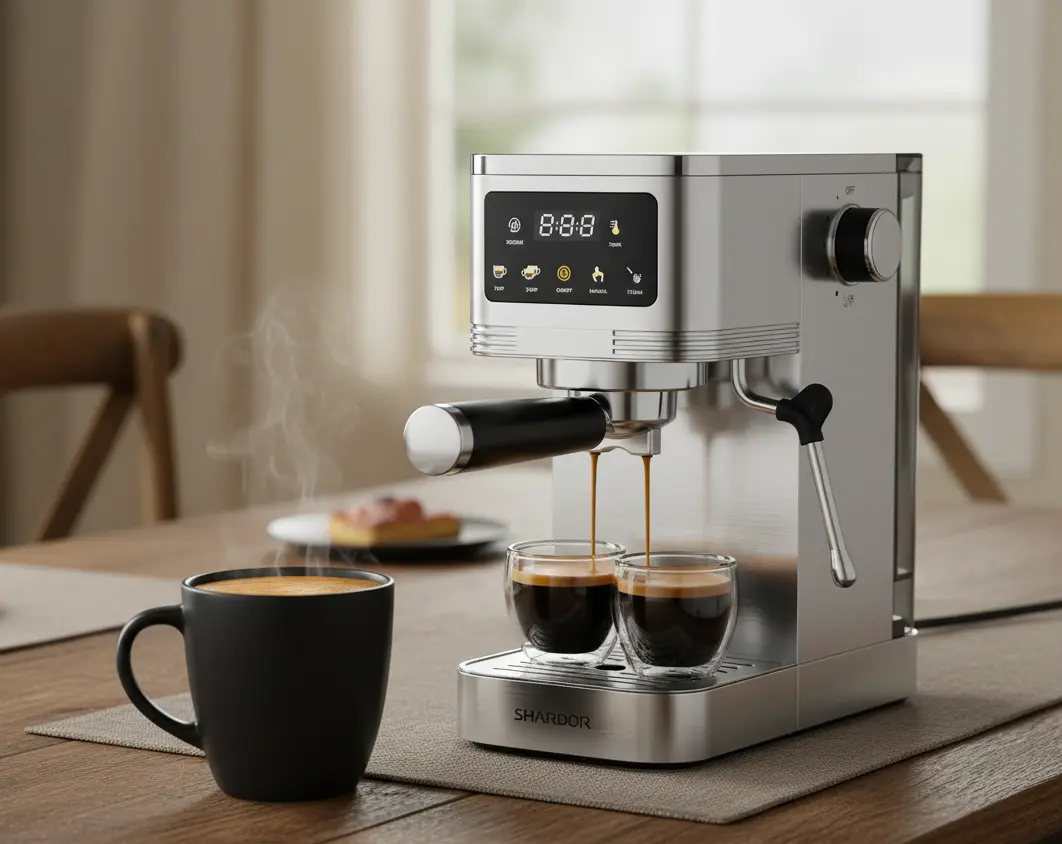
Key Brewing Differences Between Coffee Makers and Espresso Machines
Pressure levels differ greatly between coffee makers and espresso machines. Espresso machines use about 9 bars of pressure to force water through finely ground coffee. Coffee makers rely on gravity alone, with very low pressure, making a milder cup.
Brewing time also varies. Espresso machines brew very quickly, usually in 25-30 seconds. Coffee makers take several minutes to drip water through the grounds, often 4-6 minutes, producing a lighter flavor.
Water temperature is key for flavor. Espresso machines keep water at a steady 190-200°F, ideal for extracting rich oils. Coffee makers use a slightly lower temperature, around 195°F, which is good for a smoother taste but less intense.
How Grind Size Affects Flavor in Coffee Makers vs Espresso Machines
Coarse grounds suit coffee makers best. They allow water to flow easily through the coffee. This creates a smooth, mild taste. Coffee makers use gravity, so coarse grounds prevent clogging.
Fine grounds are perfect for espresso machines. The fine powder slows water flow. This lets water extract rich flavors quickly under high pressure. It results in a strong, bold taste with crema on top.
| Grind Size | Effect on Taste | Machine Compatibility |
|---|---|---|
| Coarse | Smoother, milder coffee | Coffee Maker (Drip) |
| Fine | Stronger, richer espresso | Espresso Machine |
Flavor and Strength: Coffee Maker vs Espresso Machine Taste Test
A coffee maker brews coffee by dripping hot water over coarser ground beans. The result is a milder and less concentrated drink with a smooth, balanced flavor. It usually produces larger cups of coffee that are lighter in strength.
An espresso machine forces hot water at high pressure through very fine coffee grounds. This method creates a strong, rich shot with a thick layer of crema on top. The flavor is intense and bold, perfect for those who want a concentrated coffee experience.
| Aspect | Coffee Maker | Espresso Machine |
|---|---|---|
| Grind Size | Coarse | Fine |
| Strength | Mild | Strong |
| Brewing Method | Drip, gravity-based | Pressure-based |
| Flavor | Balanced and smooth | Bold and intense |
Maintenance and Ease of Cleaning: Coffee Makers vs Espresso Machines
Keeping your coffee machine clean makes every cup taste better. It also helps your machine last longer and run smoothly.
Coffee Makers: Easy to clean and care for. Most have removable filters and carafes that you can rinse or wash fast. Run a vinegar cycle once a month to keep it fresh.
Espresso Machines: Espresso machines need regular maintenance to brew great coffee and last longer. Rinse the portafilter and wipe the steam wand after each use to prevent buildup and keep flavor clean.
A quick daily clean saves time later. I once skipped cleaning for a week — my espresso turned bitter fast. A few minutes of care each day keeps the taste perfect and the machine happy.
If you want less work, go with a drip or pod machine. But if you enjoy making café-style drinks, a bit of extra cleaning is worth it.
Cost Comparison and Long-Term Value
If you’re wondering which option gives more value over time, you’re not alone. Price matters — but so does what you get for that price. Let’s look at both sides before you make your choice.
| Aspect | Coffee Maker | Espresso Machine |
|---|---|---|
| Price Range | $30 – $150 | $100 – $1000+ |
| Upkeep Cost | Low | Moderate |
| Ease of Use | Simple | Needs some skill |
| Durability | 3–5 years | 5–10 years |
| Long-Term Value | Great for daily users | Best for espresso fans |
A coffee maker is easy on the wallet. It’s great if you want tasty coffee without spending much. Most need quick cleaning and low-cost filters. Over time, it stays practical and saves money each day.
An espresso machine costs more upfront but is worth it. You can skip café visits and make rich shots at home. It also lets you adjust flavor and strength your way. After a few months, mine paid for itself — no more $5 espresso runs!
Best Alternatives to Espresso Machines
The Moka Pot uses steam pressure to push hot water through coffee grounds. This creates a strong, rich coffee similar to espresso. It is simple to use on a stovetop and does not require electricity.
The French Press can make a strong coffee by using a fine grind and longer brewing time. It does not create pressure but extracts more flavor than regular drip coffee. The result is bold but less concentrated than espresso.
The Aero Press uses air pressure to push water through coffee grounds quickly. It makes a smooth, strong coffee that some say is close to espresso. It is lightweight and easy to clean, perfect for travel.
Common Misconceptions
A regular coffee maker can not make true espresso. Espresso needs high pressure to extract rich flavors and oils. Coffee makers use gravity, so they do not create this pressure. Espresso also requires a very fine grind of coffee beans. Coffee makers use coarser grounds that don’t work well for espresso.
Espresso brewing forces hot water through grounds quickly, making a strong, concentrated shot with crema. Coffee makers slowly drip water, resulting in milder coffee. Using espresso grounds in a coffee maker will produce a weaker, bitter drink that lacks crema and richness.
To get a stronger coffee taste with a coffee maker, try using a slightly finer grind than usual but not espresso fine. Avoid using espresso grounds directly to prevent clogging and bitterness.
How to Choose Between a Coffee Maker and an Espresso Machine
Cost is an important factor when choosing a coffee maker or espresso machine. Coffee makers usually cost less and are easier on the budget. Espresso machines tend to be more expensive because they have extra parts and use high pressure to brew.
Convenience varies between the two. Coffee makers are simple to use and clean. Espresso machines often need more time and skill to operate. Some espresso machines offer features like built-in grinders or steam wands for milk frothing, adding to their convenience.
Taste preferences matter a lot. Coffee makers brew milder coffee with a larger volume. Espresso machines create a strong, concentrated shot with rich flavor and crema. Those who enjoy bold coffee might prefer an espresso machine. People who like smooth and simple coffee may choose a coffee maker instead.
Final Thoughts: Coffee Maker vs Espresso Machine — Which Should You Buy?
Choosing between a coffee maker and an espresso machine depends on your taste. Coffee makers brew mild, larger cups using gravity. Espresso machines use pressure for a strong, concentrated shot. Each uses different grind sizes and brewing methods. You can try alternatives like a Moka pot or AeroPress for espresso-like coffee.
Understanding these differences helps you pick the right device. Enjoy your coffee, your way.
FAQs:
Can A Regular Coffee Maker Make Espresso?
No, a regular coffee maker cannot make true espresso. Espresso needs high pressure and fine grounds, which drip coffee makers lack.
Which Is Better, An Espresso Machine Or A Coffee Maker?
Espresso machines brew strong, concentrated coffee using high pressure. Coffee makers produce milder, drip-style coffee slowly. Choose based on taste preference and budget.
Are Coffee Machine And Espresso Machine The Same?
No, a coffee machine brews coffee using gravity, while an espresso machine forces water through coffee under high pressure for a stronger shot.
Is 2 Shots Of Espresso The Same As A Cup Of Coffee?
Two shots of espresso are stronger and more concentrated than a regular cup of coffee. They differ in flavor, caffeine content, and brewing method.
What Is The Main Difference Between A Coffee Maker And Espresso Machine?
A coffee maker brews drip coffee using gravity; an espresso machine forces hot water through fine grounds under pressure.

Hi, I’m Joshua Miller, a U.S.-based food lover, review writer, and Co-founder of KitchenWink.com. I hold a Bachelor of Science in Food Science and Culinary Technology, and for over five years I’ve been testing kitchen gadgets like air fryers, blenders, and other cooking tools.
I’m also a home cook, so every product I review is tried in real kitchens—not just in theory. My reviews are based on real results, simple fixes, and tips that anyone can use. With both formal training and hands-on testing, I make sure my advice is clear, honest, and practical.
My goal is simple: to help home cooks choose the right tools and make cooking easier every day.

